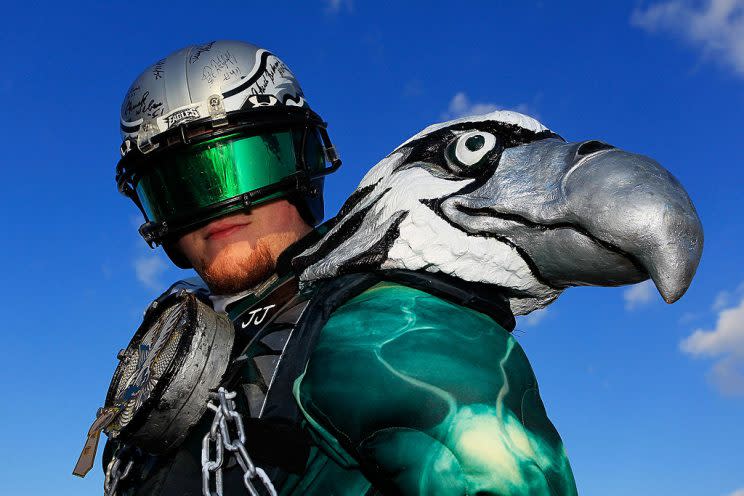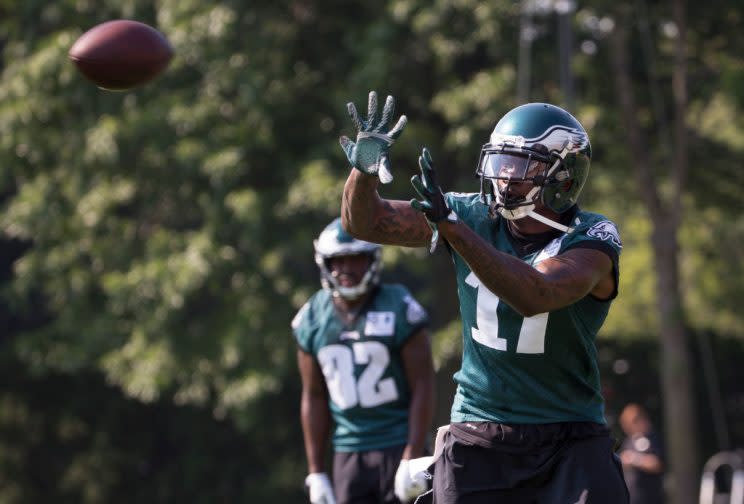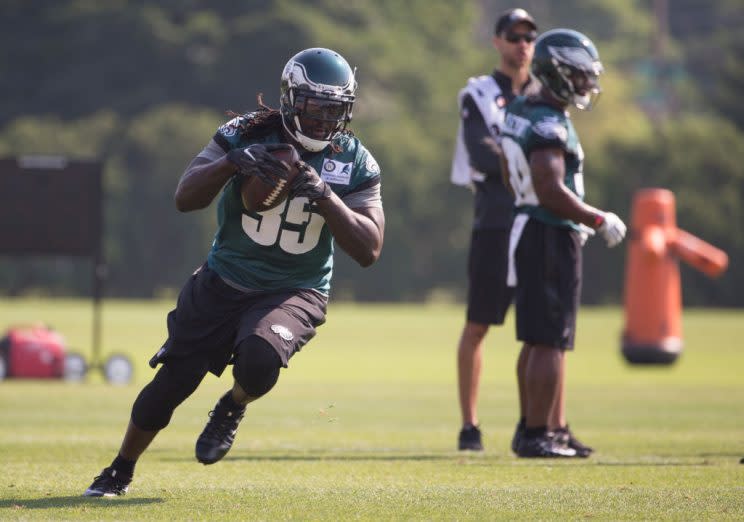Juggernaut Index, No. 21: Eagles retooled offense needs Wentz to make a leap

Carson Wentz opened his NFL career with three straight wins, efficiently carving up the defenses of the Browns, Bears and Steelers. In those three September games, he completed 64.7 percent of his throws while averaging 256.3 yards per game and 7.54 per attempt. He tossed five touchdown passes and zero picks, posting a passer rating of 103.8. Wentz, in short, was terrific — a quick-thinking, mobile QB with plenty of arm. He certainly looked the part of a top-of-draft quarterback, a franchise cornerstone.
[Now’s the time to sign up for Fantasy Football! Join for free]
And then the calendar flipped to October. No one would have guessed it at the time, but Wentz’s best games were already behind him. Losses piled up, as did turnovers. Wentz was punished by the better defenses on Philadelphia’s schedule. Here’s a look at his month-by-month performance:
September – 7.54 Y/A, 64.7 CMP%, 5 TD, 0 INT
October – 6.01 Y/A, 66.7 CMP%, 4 TD, 3 INT
November – 6.51 Y/A, 60.1 CMP%, 2 TD, 5 INT
Dec. & Jan. – 5.53 Y/A, 60.5 CMP%, 5 TD, 6 INT
After Wentz’s early binge, he began a gradual descent toward mediocrity, and eventually to something worse. When all the numbers were in, he had nearly as many interceptions (14) as TD passes (16). He ranked near the bottom of the league in Y/A (6.23), behind guys like Case Keenum (6.84), Ryan Fitzpatrick (6.73) and Blake Bortles (6.25). Wentz completed a respectable 62.4 percent of his throws, but he averaged just 3.3 air yards per attempt, again ranking among the NFL’s sketchiest passers. (Keenum averaged 3.7, Osweiler 3.6 and Bortles 3.3).

Simply put, Wentz wasn’t good. We need to give him a partial pass because he was tossed into the fire as a first-year pro, but let’s also keep in mind that he wasn’t some 21-year-old kid. That excuse can fly for Jared Goff, but not Carson. In fact, Wentz is a year older than both Marcus Mariota and Jameis Winston. He’s only eight months younger than Bortles, a player entering his fourth year in the league. Wentz will turn 25 before the end of the 2017 season; we have to assume he’s closer to a finished product than other recently drafted QBs.
Wentz spent much of his offseason working on throwing mechanics and footwork, while the Eagles’ front office spent time and resources adding talent at the offensive skill spots. If Wentz can’t make a significant leap in his second NFL season, his supporting cast won’t be to blame.
Welcome to Philly, Alshon Jeffery
Jeffery was the biggest (but not only) addition to Philadelphia’s receiving corps, and the team landed him on a one-year, make-good contract. Considering the modest commitment, it’s tough not to like the deal from the team’s perspective. When Jeffery is at his best, he’s one of the NFL’s elite downfield threats, uncommonly gifted in jump-ball scenarios. He has the size, strength and skills to win one-on-one battles on any route, at any level. Jeffery also has an 89-catch, 1421-yard season to his credit, so we know he’s capable of sustained WR1-level performance. But he also has a PED suspension on his resume, and he’s struggled with soft-tissue injuries. He’s hardly a lock to give us 16 games.
Early drafters seem to be thinking only of Jeffery’s ceiling and not his problematic floor, as his ADP in Yahoo leagues is 33.2. That’s too rich for me, considering his up-and-down history and the quality of his quarterback.

Torrey Smith signed a three-year deal with the Eagles (with very little guaranteed money), and he’ll battle third-year receiver Nelson Agholor for snaps and targets and relevance. Smith has been miscast as a do-it-all receiver at multiple NFL stops, but he’s undeniably a dangerous big-play vertical threat. As a fantasy commodity, he’s well suited for best-ball formats, where you don’t need to predict the week in which he’ll deliver his three-catch, 90-yard, two-TD game. He figures to be a low-volume field-stretcher, a guy who makes life easier for the short-to-intermediate route-runners.
We should note that Wentz’s pre-draft scouting reports generally praised his deep-ball ability, but that take wasn’t well supported by stats. Wentz was not particularly accurate on deep strikes at North Dakota State, and he completed just 31.0 percent of his deep throws last season, per Player Profiler. Smith and Jeffery should at least help make his downfield passing stats look a bit better, even if the throws aren’t perfectly placed. Wentz attempted 4.4 deep throws per game last season, so Doug Pederson’s team isn’t afraid to take shots.
Jordan Matthews has dealt with knee tendinitis throughout the offseason, but Philly’s slot receiver is expected to be ready for the opening of camp. We’ll see. He’s entering a contract year and his targets will surely take a hit this season, following the additions to the Eagles’ receiving corps. Matthews has never finished a season with less than 800 receiving yards, but he’s also never reached 1000. Ideally, you’ll draft him as a bench WR in fantasy, if you draft him at all. Agholor spent a fair amount of time in the slot during the offseason, generating modest spring buzz, but he isn’t likely to break out unless injuries clear a path. Fourth-round rookie Mack Hollins is an interesting size/speed combo player (6-foot-4, 4.53), but he’s buried on the depth chart at the moment.
Zach Ertz returns at tight end for what feels like his twelfth season, but is actually only his fifth. He finished eighth among fantasy scorers at his position last year and ranked fifth in targets (106). He remained a TD-challenged player, however, finishing with only four spikes. (When a QB averages just one touchdown pass per game, no receiver is going to feast.) Ertz saw 17 red-zone chances last season, so it isn’t crazy to expect him to retain his fantasy value, even if his targets take a small dip.
The Eagles backfield is stuck in committee
Philadelphia signed LeGarrette Blount to a one-year deal back in May, and he projects as the team’s primary early-down runner. Blount, of course, is coming off a ridiculous season for New England, rushing for a career high 1161 yards and a league-leading 18 TDs. He averaged just 3.9 YPC for the Pats, but no one ever suggested he was the game’s most elusive back. He won’t repeat last year’s 299 carries, but it’s not unreasonable to hope for something like 200 carries for 800 yards and 8-10 TDs. At his current ADP (77.1, RB23), there’s room for profit. Blount is entering his age-30 season and he’s never served as a credible receiving threat, so don’t expect anything more than his usual 5-7 catches.

Darren Sproles averaged 4.7 yards per carry and 8.2 per catch last season at age 33, reinforcing his status as an all-time outlier. He’s too small and too old, but he stubbornly continues to produce exceptionally well on a per-touch basis. He remains a bankable PPR asset, entering what might be his final NFL season. Sproles is one of the most thrilling players of his era and a historic oddity. It’s important to recognize that he does not come off the field in red-zone and goal-to-go situations, despite his size (5-foot-6, 190). Sproles handled 18 red-zone carries last year, and his 13 red-zone targets ranked fifth among all RBs.
Philly used a fourth-round draft pick on San Diego State back Donnel Pumphrey, the NCAA’s career rushing leader. (For the record, we realize Ron Dayne still has a valid claim on the rushing mark. But this is not the place to settle that dispute.) Pumphrey performed poorly at the combine in all areas — 4.48-speed isn’t enough for a 175-pound player — but, again, he was a hugely productive player with an excellent collegiate highlight reel. He was a capable receiver and route-runner for the Aztecs, too, catching 99 career passes. It’s clear the Eagles intend to get him on the field in his first pro season…
Pumphrey keeps gettting significant work with the 1s. Don’t want to overstate what happens in June, but Eagles are prepping him for a role
— Zach Berman (@ZBerm) June 13, 2017
…so keep him in your deep league and dynasty plans. He was running ahead of second-year back Wendell Smallwood during the offseason.
Ryan Mathews is still in the team picture as of this writing, but he’s recovering from a herniated disc and likely to be released when medically cleared. Waiting on his release will save the team a payout and cap hit. Because the NFL is cruel like that. Mathews turns 30 in October and his medical file is thick, so he’s no lock to make an impact anywhere.
Philadelphia’s defense is for streamers only
The Eagles were an almost perfectly average defense in every way last season, and the team lacks an elite IDP. Philly used its first three draft picks to address the D, and two of those selections — DE Derek Barnett and CB Sidney Jones — could eventually be special players. For now, this group is strictly a matchup play in fantasy. The team’s early season schedule isn’t too appealing for our purposes, so you can ignore this unit at the draft table.
2016 Offensive Stats & Ranks
Points per game – 22.9 (16)
Pass YPG – 224.1 (24)
Rush YPG – 113.3 (11)
Yards per play – 5.0 (29)
Plays per game – 67.5 (4)
—
Previous Juggernaut Index entries: 32) NY Jets, 31) San Francisco, 30) Cleveland, 29) LA Rams, 28) Baltimore, 27) Chicago, 26) Minnesota, 25) Detroit, 24) Denver, 23) Jacksonville, 22) Buffalo, 21) Philadelphia


